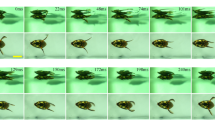Abstract
The virtual diving experience learning system of “Ama”, Japanese traditional female divers, has been developed to simulate how divers move in a virtual space using the diving interface and utilizing an accelerometer and a gyroscope. This interface not only detects the diving motion but also outputs the movement. Diving motion is shown in the ways of hand motion while standing. Although this makes it possible for a learner to understand the divers’ actions more clearly, this system’s difficulty is in visualizing a divers’ actions including their hands or bodies. Therefore, our study focuses on developing the operation system to reproduce actual ways of Amas’ diving with a virtual human body in a virtual space. First, the motion capture was done in an underwater condition. In the next process, the virtual human body was created. Finally, with the motion viewer, the more vivid actions of the Ama were successfully reproduced much more than in previous attempts. Using this system, the effectiveness of the Amas’ movement learning was confirmed, because a learner practices Amas’ movement.



























Similar content being viewed by others
References
Tanabe S (1993) Things and man’s cultural history 73 Ama. Hosei University Press, Tokyo (Japanese)
Abe N, Yamada T, Suga M (2005) Development of walkthrough-type fire simulator (fire cube) based on virtual reality technique. J Jpn Soc Saf Eng 44(3):190–196 (Japanese)
Watanuki K, Wilson JF (2008) Mixed reality-based casting skill transfer and human resource development. Int Conf Bus Technol Transf 2008(4):66–78
Hosokawa Y, Sakuraba Y, Abe Y (2009) The production of the virtual diving experience learning system to protect and develop the culture of Hokugen no Ama—the Female Divers in the Farthest North Japan—and its demonstrations at Schools. In: Proceedings of the annual conference on International Simulation and Gaming Association, 110031(CD-ROM). Singapore
Hosokawa Y, Doi A, Takata T, Abe Y (2013) Improvement of diving interface for virtual diving experience learning system. In: Proceedings of the annual conference on NICOGRAPH International 2013. Japan, pp 40–43
Jesus KD, Jesus KD, Figueiredo P, Vilas-Boas JP, Fernandes RJ, Machado LJ (2015) Reconstruction accuracy assessment of surface and underwater 3D motion analysis: a new approach. Comput Math Methods Med 2015:1–8
Bernardina GRD, Cerveri P, Barros RML, Marins JCB, Silvatti AP (2016) Action sport cameras as an instrument to perform a 3D underwater motion analysis. PloS One 11(8):1–14
Magalhaes FA, Sawacha Z, Michele RD, Cortesi M, Gatta G, Fantozzi S (2013) Effectiveness of an automatic tracking software in underwater motion analysis. J Sports Sci Med 12:660–667
Motomu Nakashima M, OhgiY, Akiyama E, Kazamia N (2010) Development of a swimming motion display system for athlete swimmers’ training using a wristwatch-style acceleration and gyroscopic sensor device. Proc Eng 2(2):3035–3040
Author information
Authors and Affiliations
Corresponding author
Additional information
This work was presented in part at the 21st International Symposium on Artificial Life and Robotics, Beppu, Oita, January 20–22, 2016.
About this article
Cite this article
Hosokawa, Y., Urata, D., Doi, A. et al. The motion capturing of female divers under water and the trial production of motion viewers for developing a virtual diving experience learning system. Artif Life Robotics 22, 346–356 (2017). https://doi.org/10.1007/s10015-017-0359-0
Received:
Accepted:
Published:
Issue Date:
DOI: https://doi.org/10.1007/s10015-017-0359-0




